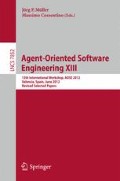Abstract
Pervasive computing is concerned with making our lives easier through digital environments that are sensitive, adaptive, and responsive to human needs. Different approaches have shown the suitability of the agent paradigm for the development of pervasive applications. However, so far no dominant approach has been adopted for the development of agent-based pervasive systems. In particular, two key classes of approaches exist, based on FIPA interaction protocols and tuple spaces. The contribution of this paper is the comparison and evaluation of tuple spaces and FIPA-compliant coordination mechanisms for the development of pervasive applications. We are therefore going to compare two approaches that exemplify these agent technologies: MalacaTiny-Sol and SAPERE.
Access this chapter
Tax calculation will be finalised at checkout
Purchases are for personal use only
Preview
Unable to display preview. Download preview PDF.
References
Saha, D., Mukherjee, A.: Pervasive computing: a paradigm for the 21st century. Computer 36(3), 25–31 (2003)
Henricksen, K., Indulska, J., Rakotonirainy, A.: Modeling context information in pervasive computing systems. In: Mattern, F., Naghshineh, M. (eds.) PERVASIVE 2002. LNCS, vol. 2414, pp. 167–180. Springer, Heidelberg (2002)
Sadri, F.: Ambient intelligence: A survey. ACM Comput. Surv. 43(4), 36:1–36:66 (2011)
Cook, D.J., Augusto, J.C., Jakkula, V.R.: Ambient intelligence: Technologies, applications, and opportunities. Pervasive and Mobile Computing 5(4), 277–298 (2009)
Omicini, A., Denti, E.: From tuple spaces to tuple centres. Science of Computer Programming 41(3), 277–294 (2001)
FIPA: The Foundation for Intelligent Physical Agents, http://www.fipa.org/
Ayala, I., Amor, M., Fuentes, L.: An agent platform for self-configuring agents in the internet of things. In: Third International Workshop on Infrastructures and Tools for Multiagent Systems, ITMAS 2012, pp. 65–78 (2012)
Castelli, G., Mamei, M., Rosi, A., Zambonelli, F.: Pervasive middleware goes social: The sapere approach. In: Fifth IEEE Conference on Self-Adaptive and Self-Organizing Systems Workshops (SASOW), pp. 9–14 (October 2011)
Labrou, Y., Finin, T., Peng, Y.: The current landscape of agent communication languages. Intelligent Systems 14, 45–52 (1999)
Ayala, I., Amor, M., Fuentes, L.: Self-configuring agents for ambient assisted living applications. Personal and Ubiquitous Computing, 1–11 (2012)
Amor, M., Fuentes, L.: Malaca: A component and aspect-oriented agent architecture. Information and Software Technology 51(6), 1052–1065 (2009)
Oracle: Sun SPOT world, http://www.sunspotworld.com/
Libellium: Waspmote, http://www.libelium.com/products/waspmote
Libellium: Meshlium Xtreme, http://www.libelium.com/products/meshlium
Mamei, M., Zambonelli, F.: Programming pervasive and mobile computing applications: the tota approach. ACM Trans. Software Engineering and Methodology 18(4) (2009)
Rodriguez, M., Favela, J., Martinez, E., Munoz, M.: Location-aware access to hospital information and services. IEEE Transactions on Information Technology in Biomedicine 8(4), 448–455 (2004)
Mamei, M., Zambonelli, F.: Field-Based Coordination for Pervasive Multiagent Systems, 1st edn. Springer Publishing Company Incorporated (2010)
Sant’Anna, C., Lobato, C., Kulesza, U., Garcia, A., Chavez, C., Lucena, C.: On the quantitative assessment of modular multi-agent system architectures. NetObjectDays (MASSA) 224 (2006)
Scholtz, J., Consolvo, S.: Toward a framework for evaluating ubiquitous computing applications. IEEE Pervasive Computing 3(2), 82–88 (2004)
Author information
Authors and Affiliations
Editor information
Editors and Affiliations
Rights and permissions
Copyright information
© 2013 Springer-Verlag Berlin Heidelberg
About this paper
Cite this paper
Ayala, I., Amor, M., Fuentes, L., Mamei, M., Zambonelli, F. (2013). Developing Pervasive Agent-Based Applications: A Comparison of Two Coordination Approaches. In: Müller, J.P., Cossentino, M. (eds) Agent-Oriented Software Engineering XIII. AOSE 2012. Lecture Notes in Computer Science, vol 7852. Springer, Berlin, Heidelberg. https://doi.org/10.1007/978-3-642-39866-7_5
Download citation
DOI: https://doi.org/10.1007/978-3-642-39866-7_5
Publisher Name: Springer, Berlin, Heidelberg
Print ISBN: 978-3-642-39865-0
Online ISBN: 978-3-642-39866-7
eBook Packages: Computer ScienceComputer Science (R0)

